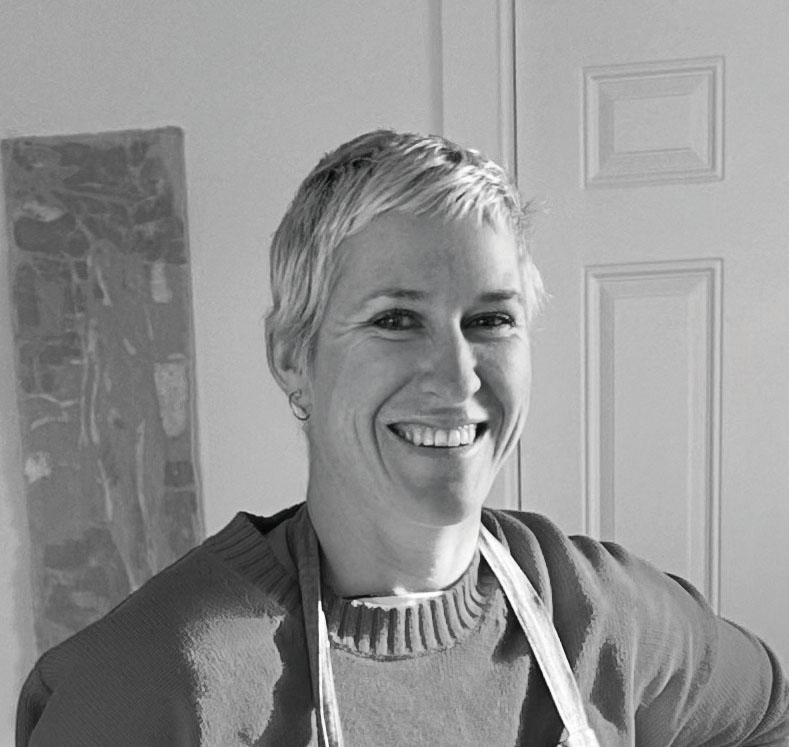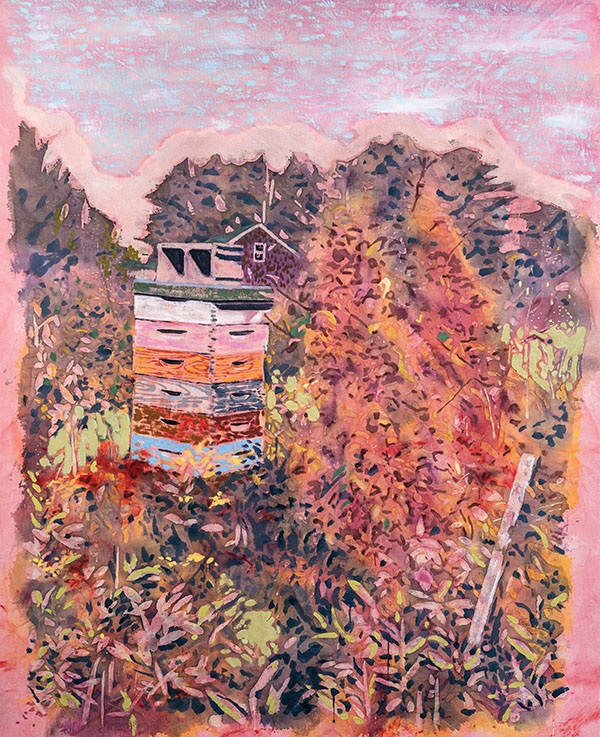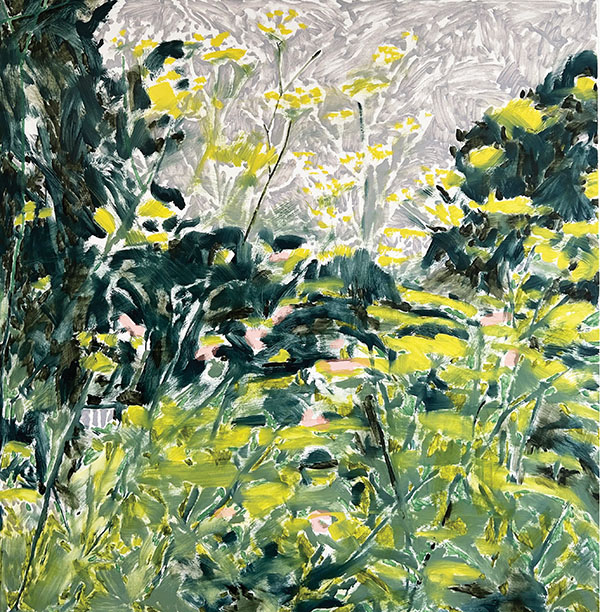Tessa Greene O’Brien

The first-floor studio on Broadway in South Portland is a relatively new space for Tessa Greene O’Brien. She moved in May of 2023 after completing a nine-month residency fellowship at Colby College’s Lunder Institute for American Art in Waterville. Thanks to a grant from the Elizabeth Greenshields Foundation, she has the studio for a year.
It’s an uncomplicated place, plenty of light, a few tables covered with painting supplies, and two armchairs, which were inspired by her Lunder residency. “I never had good chairs in the studio and we would always just perch,” O’Brien notes. “The chairs at Colby were kind of a game changer.”
While in Waterville, O’Brien worked on new paintings, which included scenes from around the city. She also completed a monumental mural, Fields Alive with Pollen and Wings, for the entrance of the new Paul J. Schupf Center. The title comes from the poem “In Praise of Hands” by Stuart Kestenbaum, former Maine poet laureate. Prompted by an image of people losing their connection to nature, O’Brien represents four Maine habitats—meadow, forest, pond edge, and aquatic—and their diverse flora and fauna. It’s breathtaking.
O’Brien has a second studio at her home in South Portland though it’s more of a business space at the moment—“I don’t like to mix creative and taxes,” she says with a smile. Her husband, artist Will Sears, is set up in the garage, which was refitted and insulated to house his wood shop.
O’Brien describes herself as a “nomadic studio person,” thanks to the many residencies she has attended over the years, mostly in Maine. They include Surf Point in York (she’s now on the board there), Monson Arts, Hewnoaks Artist Colony on Lake Kezar, the Stephen and Palmina Pace House in Stonington, the StudioWorks Artist-in-Residence Program at the Tides Institute in Eastport, and the aforementioned Lunder gig.
Through these postings, O’Brien has learned that she likes novelty and thrives in varied conditions. She enjoys entering a fresh space and breaking with any preconceived ideas about how to proceed. “The ideas get readdressed every time,” she says, “and I think that has moved the work forward.”

Subject matter shifts according to locale: “I am site absorbent,” O’Brien says. Among the work from her Monson residency—she was in the first cohort of artists in 2018—are paintings of a broad-roofed barn, the post office loading dock, and Lake Hebron. While in Eastport she painted several images of the waterfront, including Horizon Eater, which pits a lobster boat against a cruise ship.
O’Brien finds much of her subject matter in her surroundings, “whatever is catching my interest at the moment.” She credits her dog Izzy for leading her to motifs, including the tennis courts in nearby Fort Williams, which appear in several paintings. She takes snapshots on their walks.
While painting a mural at the Tidewater Farm in Falmouth in 2020, O’Brien spied some beehives, which led to several paintings of these stacked wooden frames. She gravitates to such architectural structures in the landscape. “They help me make paintings,” she explains.
O’Brien’s Big Dill is one of the standouts in “Seeking Light: Plants from Shoreline to Canopy in the Arts and Sciences” at the University of New England Gallery (through January 7). This winter she will be part of a group exhibition at the Vardan Gallery in Los Angeles and a Maine artist couple show in Katherine Bradford’s studio at Fort Andross in Brunswick.

O’Brien and Sears have contributed to the greater Portland community as muralists. She is also an advocate of fellow artists. She co-directed the Able Baker Contemporary gallery for several years and recently co-curated the exhibition “Asters & Goldenrod” with Hilary Schaffner at the Alice Gauvin Gallery (the title comes from Robin Wall Kimmerer’s Braiding Sweetgrass). “It’s a very good exercise for me as an artist to think about other people’s work critically,” O’Brien notes, “and it’s fun: I love studio visits.”
Originally from St. George in Maine’s midcoast, O’Brien attended Skidmore (BA) and the Maine College of Art (MFA). She has lived in the Portland area for almost twenty years and has no plans to leave. “Maine is in my DNA,” she says. And in her art.
